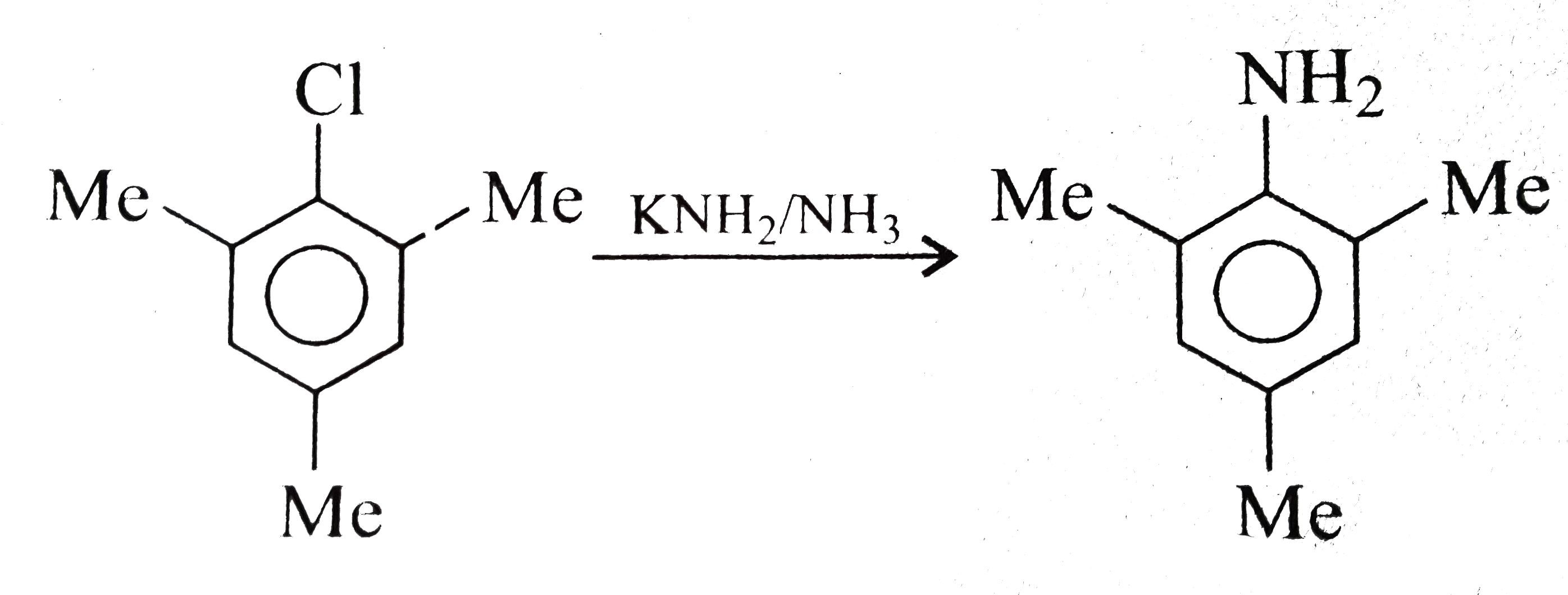Which of the following reactions are feasible ?




The correct Answer is:A, B
To determine the feasibility of the given reactions, we need to analyze each one based on the presence of alpha hydrogens and the nature of the reactants involved. Here’s a step-by-step breakdown of the reactions:
Step 1: Analyze Reaction A
Reaction: Chlorobenzene + KNS2 + NH3
1. Identify the structure: Chlorobenzene has a chlorine atom attached to a benzene ring.
2. Check for alpha hydrogens: Alpha hydrogens are the hydrogens on the carbon adjacent to the carbon bearing the leaving group (in this case, chlorine). Chlorobenzene has no alpha hydrogens since the benzene ring does not have any carbon adjacent to the carbon with chlorine that has hydrogen atoms.
3. Conclusion: Since there are no alpha hydrogens, the reaction is not feasible.
Step 2: Analyze Reaction B
Reaction: Chlorobenzene + KNS2 + NH3 (with a methyl group)
1. Identify the structure: This is a substituted chlorobenzene with a methyl group (C6H5-CH3).
2. Check for alpha hydrogens: The methyl group has three alpha hydrogens (the three hydrogens on the carbon adjacent to the carbon with chlorine).
3. Conclusion: Since there are alpha hydrogens present, the reaction can proceed, resulting in the substitution of chlorine with the NS2 group.
Step 3: Analyze Reaction C
Reaction: Bromobenzene + KNS2 + NH3 (with an ethyl group)
1. Identify the structure: Bromobenzene with an ethyl group (C6H5-CH2-CH3).
2. Check for alpha hydrogens: The ethyl group has two alpha hydrogens, but the bromobenzene itself does not have any alpha hydrogens.
3. Conclusion: Since bromobenzene lacks alpha hydrogens, the reaction is not feasible.
Step 4: Analyze Reaction D
Reaction: Chlorobenzene + KNS2 + NH3 (with two methyl groups)
1. Identify the structure: This is another chlorobenzene with two methyl groups (C6H5-CH3-CH3).
2. Check for alpha hydrogens: The two methyl groups provide six alpha hydrogens.
3. Conclusion: Since there are alpha hydrogens present, the reaction can proceed, resulting in the substitution of chlorine with the NS2 group.
Summary of Feasibility
- Reaction A: Not feasible (no alpha hydrogens).
- Reaction B: Feasible (alpha hydrogens present).
- Reaction C: Not feasible (no alpha hydrogens).
- Reaction D: Feasible (alpha hydrogens present).
Reaction: Chlorobenzene + KNS2 + NH3
2. Check for alpha hydrogens: Alpha hydrogens are the hydrogens on the carbon adjacent to the carbon bearing the leaving group (in this case, chlorine). Chlorobenzene has no alpha hydrogens since the benzene ring does not have any carbon adjacent to the carbon with chlorine that has hydrogen atoms.
3. Conclusion: Since there are no alpha hydrogens, the reaction is not feasible.
Reaction: Chlorobenzene + KNS2 + NH3 (with a methyl group)
2. Check for alpha hydrogens: The methyl group has three alpha hydrogens (the three hydrogens on the carbon adjacent to the carbon with chlorine).
3. Conclusion: Since there are alpha hydrogens present, the reaction can proceed, resulting in the substitution of chlorine with the NS2 group.
Reaction: Bromobenzene + KNS2 + NH3 (with an ethyl group)
2. Check for alpha hydrogens: The ethyl group has two alpha hydrogens, but the bromobenzene itself does not have any alpha hydrogens.
3. Conclusion: Since bromobenzene lacks alpha hydrogens, the reaction is not feasible.
Reaction: Chlorobenzene + KNS2 + NH3 (with two methyl groups)
2. Check for alpha hydrogens: The two methyl groups provide six alpha hydrogens.
3. Conclusion: Since there are alpha hydrogens present, the reaction can proceed, resulting in the substitution of chlorine with the NS2 group.
- Reaction A: Not feasible (no alpha hydrogens).
- Reaction B: Feasible (alpha hydrogens present).
- Reaction C: Not feasible (no alpha hydrogens).
- Reaction D: Feasible (alpha hydrogens present).
Topper's Solved these Questions
- ORGANIC REACTION MECHANISMBOOK - CENGAGE CHEMISTRYCHAPTER - ORGANIC REACTION MECHANISMEXERCISE - Single correct
50 Videos
- ORGANIC REACTION MECHANISMBOOK - CENGAGE CHEMISTRYCHAPTER - ORGANIC REACTION MECHANISMEXERCISE - Assertion-Reasoning
12 Videos
- ORGANIC REACTION MECHANISMBOOK - CENGAGE CHEMISTRYCHAPTER - ORGANIC REACTION MECHANISMEXERCISE - Comprehension
36 Videos
- NCERT BASED EXERCISEBOOK - CENGAGE CHEMISTRYCHAPTER - NCERT BASED EXERCISEEXERCISE - Chemical Equilibrium
72 Videos
- P-BLOCK GROUP 13 - BORON FAMILYBOOK - CENGAGE CHEMISTRYCHAPTER - P-BLOCK GROUP 13 - BORON FAMILYEXERCISE - Exercise Archives (Subjecive)
9 Videos
Similar Questions
Knowledge Check
Which of the following reactions is/are feasible?
ACH3CH2Br++NaO−−CH3| C | CH3−CH3→CH3CH2O−CH3| C | CH3−CH3BCH3−CH3| C | CH3−Cl+Na+O−CH2CH3→CH3CH2−O−CH3| C | CH3−CH3CBoth a and bDNone of the aboveWhich of the following reactions is/are feasible:
 A(i)&(ii)B(ii),(iii)&(iv)C(i),(ii)&(iv)D(i),(iii)&(iv)
A(i)&(ii)B(ii),(iii)&(iv)C(i),(ii)&(iv)D(i),(iii)&(iv)Which of the following reactions are ot feasible?
AHC≡CH+KOH→BHC≡CH+NaNH2→CHC≡CH+NaOH→DHC≡(−)CK(+)+(CH3)3C−Br→
Which of the following reactions is feasible?
View Solution(i) Cu+2HCl2+H2(g) [ECu2+/Cu∘=.34V]
(ii)Zn+2HCl→ZNCl+(2)+H2((g)) [E(ZN2+/ZN∘=−0.76V]
(iii) Ag+2HCl→AgCl+(1)/(2)H2(g) [E(Ag+/Ag)∘=+0.80V]
Which of the following reaction is feasible ?
View SolutionWhich of the following reaction is feasible ?
View SolutionWhich of the following reaction is feasible?
View SolutionWhich of the following reaction is feasible ?
View Solution


